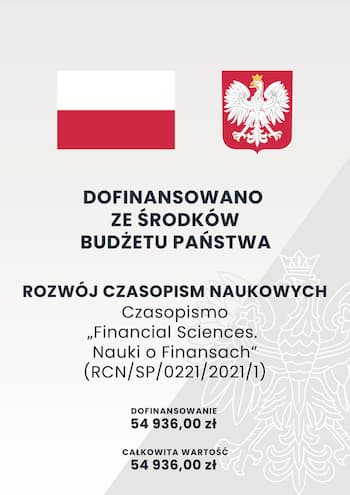Issues
Click a year to expand it.
40 Points
on Ministry of Education and Science journal evaluation list of 2024

Search results for query: Lew
Sort by: Relevance Author: Ascending Descending Year: Ascending Descending
- Financial Auditing and the Increased Risk of Fraud During the COVID-19 Pandemic
Author: Agnieszka Lew
See Issue Contents: fins.2022.2
Abstract:The article discusses the issues related to the increased risk of fraud in business units during the COVID-19 pandemic. The aim of the article was to point out the impact of the pandemic on areas that may be exposed to the embellishment of the presented financial data, as well as to show the increased risk during the audit of the financial statement, which must be taken into account by the statutory auditor when performing the financial audit. Possible solutions were identified, also recommended by the Polish regulator, that may help to sensitise the financial and accounting services to the emergence of fraud in enterprises, and in which areas increased caution should be exercised in the analysis of the presented financial data. It was also pointed out how important a role auditors have in building public trust as ethical leaders. The research methods used in the article were a review of source documents and materials issued by international organizations.
- The Customer as an Accounting Entity
Author: Magdalena Bochenek
See Issue Contents: fins.2022.1
Abstract:The aim of the article is to present the customer as an accounting entity. The article presents the growing role of the customer in enterprise management. Businesses are increasingly customer-oriented. This also results in a customer orientation of management accounting methods. Management accounting methods can be used to measure customer costs and customer value. The results of research on customer orientation of enterprises are presented. The research was conducted among enterprises based in the Podkarpackie Province with more than 49 employees. The results of the research confirmed that the employees of the enterprises consider the customer to be important for them. Respondents identified customers as the people thanks to whom they generate the most revenue. In contrast, a relatively small number of respondents identified customers as the people through whom the enterprise incurs costs and achieves economic success. Most entrepreneurs perceive customers only from the revenue side. The research methods used in the article are a critical analysis of the literature and a quantitative method, which consisted of direct research using the questionnaire technique.
- Cost analysis in the audit of selected companies in Poland
Author: Anna Mazurczak-Mąka, Monika Turek-Radwan
See Issue Contents: fins.2019.1
Abstract:The aim of the article is to present the issues related to the work of auditors in the area of cost analysis as an element of the financial statement in an enterprise. Empirical studies were conducted on the basis of the financial statements published by selected companies listed on the NewConnect market in 2017, as well as the audit reports issued for those companies. The partial goals include the assessment of the percentage of certain types of opinions issued by independent auditors reviewing the financial statements of selected companies listed, as well as the identification of the areas regarding costs of activities, which are most often described in the explanations or qualified opinions in the research sample under analysis. The undertaken research are preliminary and in the future should be carried out on a larger research sample divided into industry sectors.
- An Application of Financial IT Programmes to Support Customer Relations
Author: Maria Kubacka
See Issue Contents: fins.2022.2
Abstract:The aim of the paper is to present research on the status for the use of financial information systems and CRM systems or ERP modules for customer relationship management to support customer relations, and in particular to identify the status of the use of these systems depending on the type of an enterprise in the Podkarpackie Province. At the same time, it was examined whether the customer relationship management system was coupled with the enterprise's financial and accounting system in terms of importing customer information, and the sources of obtaining customer information were identified. On the basis of the research conducted, it should be stated that the CRM class system was functioning in almost 31% of the enterprises under the survey. As a result of the analysis of contingency tables and verification of statistical significance of the relationships studiem, and using the chi-square independence test, it was confirmed that the type of enterprise differentiated the entities in terms of the use of CRM systems (or relevant ERP modules for customer relationship management) in supporting customer relations. At the same time, the study showed that the use of customer relationship management systems was related to the indication of the desired sources of customer information. The research has filled a gap in knowledge about the use of customer relationship management systems in enterprises in the Podkarpackie Province.
Newsletter






